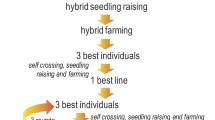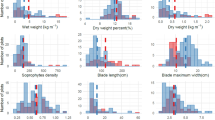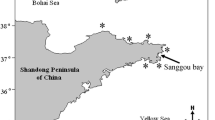Abstract
Dongfang no. 6, an intraspecific hybrid of kelp (Saccharina japonica) which was high in yield and had a high stress tolerance and was suitable for processing, was bred by crossing scientifically selected parental gametophyte clones. The sporophyte of the hybrid was raised by crossing a female gametophyte clone isolated from a Korean ecotype of S. japonica (Korean kelp) with a male gametophyte clone isolated from Lianza no. 1, a variety of S. japonica bred through continuous selection. The culture performance, stress tolerance, and suitability for processing of the hybrid and two commercial controls were compared for a period lasting 5 years (2009–2013). It was found that the hybrid was fast in growth, tolerant to high seawater temperature, resistant to strong solar irradiation, late in maturing time, and high in processed product yield. The percentage of salting processed product of the hybrid was 17.5 and 15.4 % higher than those of control 1 and 2, respectively. The yield of salting processed product of the hybrid increased by 24.2 and 38.8 % over control 1 and 2, respectively. The yield of air drying processed product of the hybrid increased by 109.4 and 88.1 % over control 1 and 2, respectively. The breeding of Dongfang no. 6 demonstrated that crossing gametophyte clones in combination with selecting desirable hybrids are highly effective for breeding kelp hybrids with high-culture performance and suitability for processing.



Similar content being viewed by others
References
Fang TC, Wu CY, Jiang BY, Li JJ, Ren GZ (1962) The breeding of a new breed of Haidai (Laminaria japonica Aresch) and its preliminary genetic analysis. Acta Bot Sin 10:197–209 (in Chinese with English abstract)
Fang TC, Ou YL, Cui JJ (1985) Breeding of hybrid Laminaria “Danza no.10”- an application of the laminarian haploid cell clones. J Shandong Coll Oceanol 15:64–72 (in Chinese with English abstract)
Ji MH (2004) Chemistry of algae. Science Press, Beijing (in Chinese)
Li XJ, Cong YZ, Yang GP, Shi YY, Qu SC, Li ZL, Wang GW, Zhang ZZ, Luo SJ, Dai HL, Xie JZ, Jiang GL, Liu JL, Wang TY (2007) Trait evaluation and trial cultivation of Dongfang no. 2, the hybrid of a male gametophyte clone of Laminaria longissima (Laminariales, Phaeophyta) and a female one of L. japonica. J Appl Phycol 19:139–151
Li XJ, Liu JL, Cong YZ, Qu SC, Zhang ZZ, Dai HL, Luo SJ, Han XB, Huang SS, Wang QY, Liang GJ, Sun J, Jin Y, Wang DQ, Yang GP (2008a) Breeding and trial cultivation of Dongfang no.3, a hybrid of Laminaria gametophyte clones with a more than intraspecific less than interspecific relationship. Aquaculture 280:76–80
Li XJ, Yang GP, Shi YY, Cong YZ, Che S, Qu SC, Li ZL (2008b) Prediction of the heterosis of Laminaria hybrids with the genetic distance between their parental gametophyte clones. J Appl Phycol 20:1097–1102
Li ZL, Zhang QS, Yang YY, Xie JZ, Luo SJ (2003) Study on the technique of large-scale culture of kelp gametophyte clones. Shandong Fish 20(5):1–3 (in Chinese)
Luo SJ, Cong YZ, Qu SC, Zhang ZZ, Li XJ, Dai HL, Wang QY, Jin Y (2008) Key techniques of kelp seedling raising by gametophyte clones. Shandong Fish 25(1):1–3 (in Chinese)
Section of Seaweed Cultivation, Institute of Marine Fisheries, Qingdao; Section of Seaweed Genetics and Breeding, Institute of Oceanology, Academia Sinica (1976) The breeding of new varieties of Haidai (Laminaria japonica Aresch.) with high production and high iodine content. Acta Genetica Sinica 1976(3):224-230 (in Chinese with English abstract)
Tian ZP, Yuan BJ (1989) Test report of breeding of a new kelp variety “Zaohoucheng no.1”. Mariculture, 1989 (1):7-16 (in Chinese)
Zhang QS, Liu SP, Qu SC, Tian ZP, Guo ZM, Cong YZ, Li ZL (2001) Studies on rearing new variety of kelp “901”. Trans Oceanol Limnol 2001(2):46-53 (in Chinese with English abstract)
Zhang QS, Tang XX, Cong YZ, Qu SC, Luo SJ, Yang GP (2007) Breeding of an elite Laminaria variety 90-1 through inter-specific gametophyte crossing. J Appl Phycol 19:303–311
Zhang ZZ, Qian R, Luo SJ, Jiang X, Sun J, Pan JH, Dai HL (2010a) Pollution prevention techniques for kelp germplasm preservation. Hebei Fish 2010 (5):30-31 (in Chinese)
Zhang ZZ, Li XJ, Qu SC, Luo SJ, Dai HL, Sun J, Qian R, Liang GJ (2010b). A secondary seed-adhering technique of Laminaria gametophyte clones. J Fujian Fish 2010 (2):9-13 (in Chinese)
Funding
This study was funded by National Supporting Program of Science and Technology of China (2012BAD55G01); National High Technology Research and Development Program (863 Program) of China (2012AA10A406), and Municipal Science and Technology Research and Development Project of Yantai (2013LGS002).
Conflict of interest
The authors declare that they have no conflict of interest.
Approval of breeding and culturing
The parental gametophytes were isolated from either cultured kelp varieties or secondary (derivative of the cultured) wild kelp blades with the isolated gametophytes cultured and maintained indoor as germplasm. The hybrid was raised indoor as was practiced in the culture of normal kelp varieties and cultured in farming areas approved and monitored by the local governments of China. For DNA isolation, the cultured gametophytes were harvested by centrifugation and frozen in liquid nitrogen immediately and stored at −80 °C till use. The breeding of this kelp hybrid and its culture and associating handling have been approved by Provincial Agricultural Bureau of Shandong and Municipal Agricultural Bureau of Yantai (on behalf of Agricultural Department of China) and the Ethics and Safety Team of Ocean University of China. The hybrid has been approved by National Committee of Aquacultured Landraces and Elite Varieties of China (GS-02-004-2013) and noticed as a kelp hybrid suitable for culture on large scales by Agricultural Department of China.
Author information
Authors and Affiliations
Corresponding author
Rights and permissions
About this article
Cite this article
Li, X., Zhang, Z., Qu, S. et al. Breeding of an intraspecific kelp hybrid Dongfang no. 6 (Saccharina japonica, Phaeophyceae, Laminariales) for suitable processing products and evaluation of its culture performance. J Appl Phycol 28, 439–447 (2016). https://doi.org/10.1007/s10811-015-0562-0
Received:
Revised:
Accepted:
Published:
Issue Date:
DOI: https://doi.org/10.1007/s10811-015-0562-0




